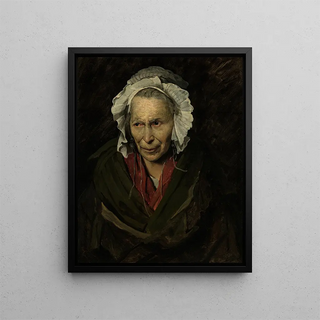Art print | Monomane de l'envie La Monomane de l'envie - Théodore Géricault


View from behind

Frame (optional)
In the panorama of 19th-century art, certain works stand out for their ability to capture human emotions in all their complexity. "Monomane de l'envie" by Théodore Géricault is one of these masterful pieces that evoke a deep and unsettling feeling. This artwork, which is part of the painter's psychological explorations, offers a poignant reflection on human nature and its obsessions. Through this canvas, Géricault invites us to delve into a world where passions consume the individual, thus revealing the dark facets of the soul.
Style and uniqueness of the work
Géricault's style is characterized by dramatic intensity and striking realism, typical of the Romantic movement. In "Monomane de l'envie," the composition is carefully orchestrated, highlighting the central character whose expression indicates palpable inner suffering. The colors, dark and earthy, emphasize the tragic nature of the scene, while the light subtly illuminates the facial features, highlighting the depth of emotions. This artwork does not merely depict a state of mind; it reveals its mechanisms, offering the viewer a glimpse into the tormented psyche of the individual. The way Géricault captures the tension between envy and suffering makes this canvas a fascinating psychological study, where each brushstroke seems charged with meaning.
The artist and his influence
Théodore Géricault, an emblematic figure of French Romanticism, knew how to mark his era with his innovative approach to painting. His fascination with drama and the human condition led him to explore themes often neglected by his contemporaries. Géricault was not afraid to draw inspiration from the sciences of his time, notably psychiatry, to enrich his works with an intellectual dimension. "Monomane de l'envie" fits into this lineage, demonstrating his interest in mental disorders and human passions. His influence endures today, inspiring many artists to approach human psychology with the same depth and sensitivity. Through his works, Géricault shows us

Matte finish

View from behind

Frame (optional)
In the panorama of 19th-century art, certain works stand out for their ability to capture human emotions in all their complexity. "Monomane de l'envie" by Théodore Géricault is one of these masterful pieces that evoke a deep and unsettling feeling. This artwork, which is part of the painter's psychological explorations, offers a poignant reflection on human nature and its obsessions. Through this canvas, Géricault invites us to delve into a world where passions consume the individual, thus revealing the dark facets of the soul.
Style and uniqueness of the work
Géricault's style is characterized by dramatic intensity and striking realism, typical of the Romantic movement. In "Monomane de l'envie," the composition is carefully orchestrated, highlighting the central character whose expression indicates palpable inner suffering. The colors, dark and earthy, emphasize the tragic nature of the scene, while the light subtly illuminates the facial features, highlighting the depth of emotions. This artwork does not merely depict a state of mind; it reveals its mechanisms, offering the viewer a glimpse into the tormented psyche of the individual. The way Géricault captures the tension between envy and suffering makes this canvas a fascinating psychological study, where each brushstroke seems charged with meaning.
The artist and his influence
Théodore Géricault, an emblematic figure of French Romanticism, knew how to mark his era with his innovative approach to painting. His fascination with drama and the human condition led him to explore themes often neglected by his contemporaries. Géricault was not afraid to draw inspiration from the sciences of his time, notably psychiatry, to enrich his works with an intellectual dimension. "Monomane de l'envie" fits into this lineage, demonstrating his interest in mental disorders and human passions. His influence endures today, inspiring many artists to approach human psychology with the same depth and sensitivity. Through his works, Géricault shows us






